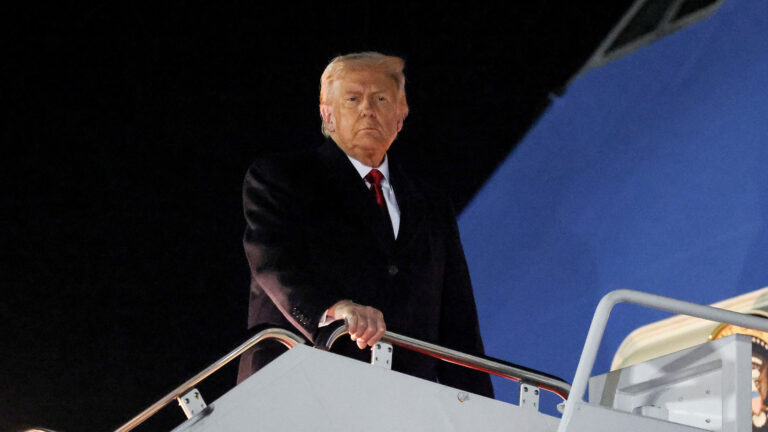Who: Real Madrid vs Barcelona
What: El Clasico in Spain’s La Liga
Where: Santiago Bernabeu in Madrid, Spain
When: Sunday at 4:15pm (14:15 GMT)
How to follow: We’ll have all the build-up on Al Jazeera Sport from 1:15pm (11:15 GMT) in advance of our live text commentary stream.
Last season, Barcelona romped to four Clasico victories over Real Madrid, but led by in-form striker Kylian Mbappe, Los Blancos are aiming to redress the balance on Sunday in La Liga.
Recommended Stories
list of 4 itemsend of list
Hansi Flick’s side won a domestic treble, beating Madrid twice in La Liga and in the Copa del Rey and Spanish Super Cup finals, precipitating the end of Carlo Ancelotti’s reign.
The Italian’s replacement, Xabi Alonso, has started well, and Madrid lead Barcelona by two points at the top of the table going into the clash at the Santiago Bernabeu.
Al Jazeera Sport takes a look at the first Clasico of the season.
What is Real Madrid’s form ahead of El Clasico?
Madrid have some doubts around them regarding their performance in big matches, having lost against Paris Saint-Germain in the Club World Cup semifinals this summer and then suffering a 5-2 thrashing by Atletico Madrid in a derby in September.
A victory in El Clasico would open up a five-point gap on their rivals and ease those concerns while Flick’s Barca are yet to reach the same level they managed last season.
What is Mbappe’s form like for Real Madrid?
Despite the doubts about Madrid’s credentials, Mbappe has hit new heights in the current campaign after finishing the previous campaign strongly.
Mbappe had scored in all 11 of his previous matches for club and country before Wednesday’s Champions League win against Juventus, in which Jude Bellingham netted the only goal.
The 26-year-old has scored 10 of Madrid’s 20 La Liga goals, leading Spain’s scoring charts, and has 15 for his club across all competitions, totalling 54 percent of their goals.
“We’re not dependent on him,” Alonso said last week, although the statistics suggest otherwise.
“We are very happy with his performance. He’s being decisive.”
Why was last season so difficult for Mbappe at Real Madrid?
Mbappe struggled for confidence and form in his early days at Madrid with his first Clasico a huge disappointment.
Exactly a year before this weekend’s Clasico, Barcelona visited the Bernabeu and came away with a 4-0 victory, a match notable for the French superstar’s struggle to beat the Catalans’ high defensive line in his first outing against them for Madrid.
Mbappe had one goal disallowed for offside and was caught offside eight times in total. The forward was “shrunken and without venom”, the Spanish newspaper AS wrote.
“It’s time to change my situation and show who I am as a player,” Mbappe pledged a few weeks later as Madrid continued to slump.
By the time Mbappe next faced Barcelona in the Spanish Super Cup final in January, he had clicked into a higher gear.
Madrid were dismantled 5-2, but Mbappe found the net, as he did in their far tighter 3-2 Copa del Rey final defeat.
In May Mbappe, now in full flow, hit a hat-trick against Barcelona, but Los Blancos still fell 4-3 at the Olympic stadium as Flick’s side virtually wrapped up the league title.
This time last year… pic.twitter.com/QCXkedaq5K
— LALIGA English (@LaLigaEN) October 24, 2025
What else is making Real Madrid tick before Barcelona clash?
This season, Turkish playmaker Arda Guler has started to form a strong connection with Mbappe, having a knack for spotting the forward’s bursts behind the defence.
“Arda gets between the lines, and there he finds Mbappe well,” Alonso explained.
With Barcelona struggling badly in defence at the start of the current campaign, Madrid are confident Mbappe will be able to get in behind to devastating effect on Sunday.
Why has Barcelona’s Yamal been in the headlines with Real Madrid?
Teenage winger Lamine Yamal has been in the spotlight in the Spanish capital after joking during an appearance on a social media stream that Real Madrid “steal” and “complain”.
Barcelona’s assistant coach said on Saturday, however, that the furore created could go the way of the youngster.
“Lamine is a top player, and I think [the criticism] will be motivating for him,” Marcus Sorg, Flick’s assistant, said at a news conference.
“I hope we all see him [give] the best performance.”
The 18-year-old Spain international will be up against Madrid left back Alvaro Carreras, whom he struggled against at times last season for Benfica on three occasions they faced Barcelona in the Champions League.
“Lamine is always motivated, and if I remember right, we won all three games against Benfica,” Sorg noted.
Why did Flick not speak before El Clasico?
Flick is suspended for the game after a red card last weekend during the win over Girona, and Sorg is taking over duties on the touchline.
“Honestly, Hansi is missing always if he is not there because he’s the most important part of the team,” Sorg said.
“It’s a disadvantage of course, [but] it’s the same as [missing] players. We have to deal with it. Everyone knows what he expects, and I think we will do it.”
Will Barcelona’s Raphinha be back for El Clasico?
Barcelona will be without winger Raphinha, who has suffered a setback in his return from a hamstring injury.
“Raphinha – every team would miss him, but it is how it is. We have enough players and have to deal with it,” Sorg said.
Head-to-head
This is the 262nd Clasico with Real claiming 105 wins and Barcelona taking the spoils on 104 occasions.
Real Madrid team news
Real Madrid hope to welcome back Trent Alexander-Arnold, Dani Carvajal, Dani Ceballos and Dean Huijsen. Antonio Rudiger and David Alaba are out due to muscle and groin injuries.
Barcelona team news
Frenkie de Jong has returned from illness, but Jules Kounde is a doubt due to a slight knock.
Raphinha’s hamstring injury is keeping him sidelined while Joan Garcia, Marc-Andre ter Stegen, Gavi, Robert Lewandowski and Dani Olmo are all confirmed absentees.
Real Madrid predicted starting lineup
Courtois; Valverde, Militao, Asencio, Carreras; Guler, Tchouameni, Bellingham; Mastantuono, Mbappe, Vinicius
Barcelona predicted starting lineup
Szczesny; E Garcia, Araujo, Cubarsi, Balde; Pedri, de Jong; Yamal, Fermin, Rashford; Ferran









 ”
”





